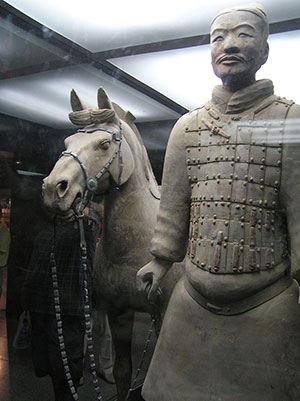
Horse and soldier. Wikipedia image
I had something else in mind for the subject of my latest blog after two more endurance fatalities and controversy (again!) over the appearance of blood on a Marilyn Little ridden event horse, but frankly I am beginning to tire of opening equestrian news sites and seeing more depressing reports of cruelty or abuse, so I decided to look at something truly beautiful to distract myself.
I love art and especially paintings and sculptures of horses. Where I live in Newmarket, England, we are very lucky in that respect because some of the greatest equestrian artists ever have plied their trade in town. On the High Street you can see the Skeaping statue of Hyperion, one of the most marvellous races horses and sires ever and in the Jockey Club Rooms behind it, are a wealth of treasures including George Stubb’s portrait of Eclipse, to some the greatest ever horse to look through a bridle.
So that got me thinking, what are greatest works of equestrian art ever? There are a lot to choose from and, of course, it is a matter of personal taste. You can go back into ancient history and see works by the Greeks and the Romans, but for sheer scale you can’t really beat the Terracotta Army in China where among the 8,000 clay warriors are nearly 700 full size horses including 150 with chariots. The scale of it beggars belief.

Kelpies. Scotland Tourism image
Talking of scale, if it is big you like, look no further than the Kelpies, the world’s biggest horse sculpture, which resides above the canals in Falkirk, Scotland. The two heads of the Kelpies rear more than 30 metres above the ground.
I have some personal favourites, though. In London’s Piccadilly Circus are Rudy Weller’s Horses of Helios, full size beasts leaping out of a fountain and easy to believe they really are the horses of the sun god dragging his fiery chariot as they leap, paw and snort in front of the tourists. Then there is the Anichkov Bridge in St Petersburg, Russia which is adorned by The Horse Tamers, glorious young men attempting to control equally glorious and life like horses.
Most people know that Degas painted ballet dancers, but his other love was racehorses and his delicate realistic sculptures of those are even less well known than his equine paintings, but are no less lovely because of that.

London nights, Horses of Helios. Lulu Kyriacou image
Many beloved racehorses have been immortalised in bronze or marble: Kauto Star at Kempton, Red Rum at Aintree, Arkle gazing over Cheltenham or his birthplace in Ireland and Secretariat galloping majestically in front of the Racing Museum at Saratoga.
The last, incidentally, is another by Skeaping and based on the horse’s legendary run in the Belmont Stakes. Talking of which reminds me of Thoroughbred Park in Kentucky. Suddenly as you come round the corner at a set of lights in downtown Lexington you see seven horses and jockeys racing long side the highway. It takes a second or two to realise they are Gwen Readon’s life size replicas.
For paintings, there Stubbs’ classic depiction of Mares and Foals needs little description. It is such an iconic image, but his full size image of the stallion Whistlejacket is equally mesmerising. Who could ignore Gericault’s Horse Frightened By Lightning, who looks so frozen in terror you might expect him to whip round and bolt off the page. Or the gay abandon of the stallion evading his pursuers in JF Herrings’ Arabs Chasing a Loose Arab Horse. Or the hopeless drudgery of the animals in the paintings of Lucy Kemp Welch, who first illustrated Black Beauty.

Thoroughbred Park. Flickr image
Back when I was a child, I was sent a magazine by my grandmother because it had an illustration of a horse painting, kept at the Tate Gallery in London. When I saw it for real, it was still powerful, but not overwhelming. Some years later, I was visiting New York and went into the shop. For sale was a poster of that very picture. “But isn’t that painting in London?” I asked the guide. “No ma’am, that is just a copy, a study for the real thing, which you will find upstairs, you won’t miss it”. The gallery guide was not wrong; you couldn’t miss it. Nothing can really prepare a horse lover for Rosa Bonheur’s The Horse Fair. Started in 1852, it took three years to complete. It is eight feet high and sixteen feet wide and full top to bottom of men and horses, milling about before a sale. The detail of each horse, the wild eyes and flexing muscles, straining at lead ropes or showing their temper, is incredible.
Keep the Mona Lisa or The Laughing Cavelier, to me this is the world’s best painting and a reminder, if one is needed, that the horse world is full of beauty and inspiration no matter how much the news seems only to report on the ugliness.
